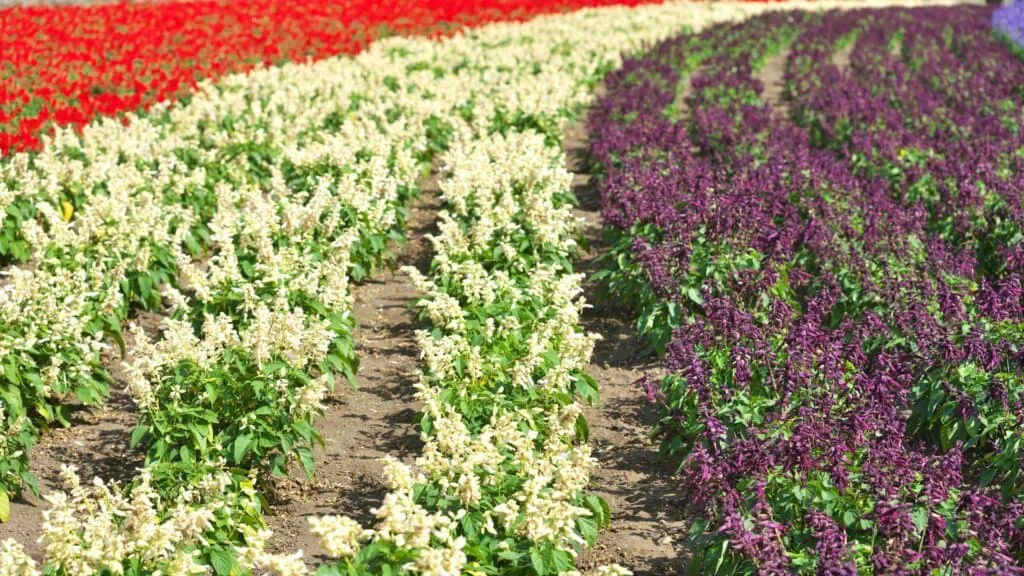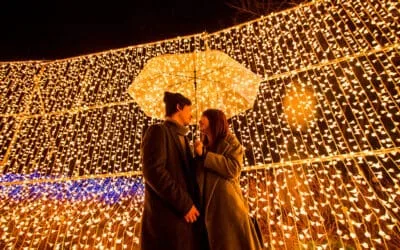Flowers in Japan carry profound meaning, offering a delightful spectacle regardless of the season or region. Among these blooms, salvia stands out for its captivating beauty, adorning landscapes across the country. To fully immerse in the charm of salvias in Japan, let’s explore its allure and uncover the best times and places to admire these blossoms in Japan.
Find out all about the different flowers in Japan you can enjoy throughout the year. Click the links to check out when and where to see Cherry Blossoms, Tulips, Azaleas, Roses, Poppies, Salvia, Hydrangea, Iris, Lavender, Indian Lotus, Sunflowers, Ume, and Moss phlox.
Salvias in Japan
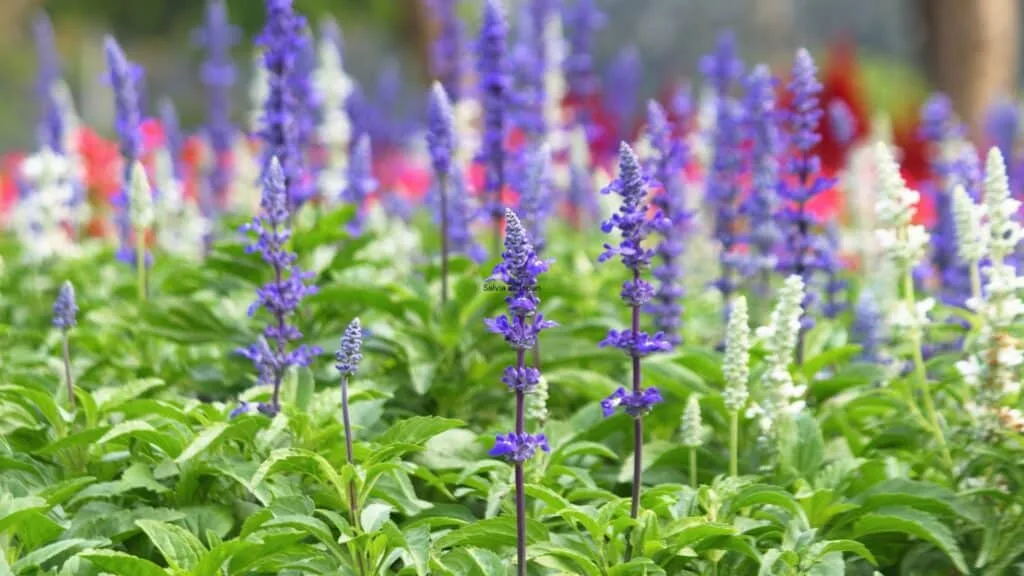
alvias, a diverse group encompassing herbs, shrubs, and subshrubs, are esteemed for their hardiness and fragrant leaves. Found across the globe, including Japan, these plants are treasured for their decorative allure and potential medicinal uses. Their leaves, which often grow oppositely along square stems, exhibit a range of shapes from simple to compound.
A distinctive characteristic of salvias lies in their floral anatomy, featuring tubular flowers with two lips and only two stamens. In Japan, specific species hold cultural importance, serving in traditional medicine and culinary traditions. Additionally, they play a vital ecological role by attracting pollinators such as bees and butterflies.
In the temperate regions of Japan, salvias embellish gardens, parks, and landscapes, enriching these spaces with vibrant hues and sweet scents. Their popularity extends beyond mere aesthetics, often adorning floral arrangements and landscaping schemes as symbols of vigour and resilience.
Valued for their versatility and minimal upkeep needs, salvias are favoured in Japanese horticulture and agriculture. Ongoing studies into their medicinal attributes further underscore their significance in Japanese society, highlighting their potential contributions to herbal remedies and pharmaceuticals.
When to see Salvias in Japan

The ideal period for experiencing the vibrant bloom of salvia in Japan varies depending on location and climate conditions. However, as a general guideline, the enchanting display of salvia typically unfolds from early May to early June.
During this time, Japan’s landscapes burst with the vivid colours of blooming salvias, offering a delightful spectacle for visitors and locals alike. This timeframe coincides with Japan’s transition from spring to early summer, adding to the natural beauty of the surroundings. Whether in urban parks or rural areas, early May to early June presents an excellent opportunity to witness the captivating allure of salvia blossoms in Japan.
Where to see Salvias in Japan
1. Mother Farm
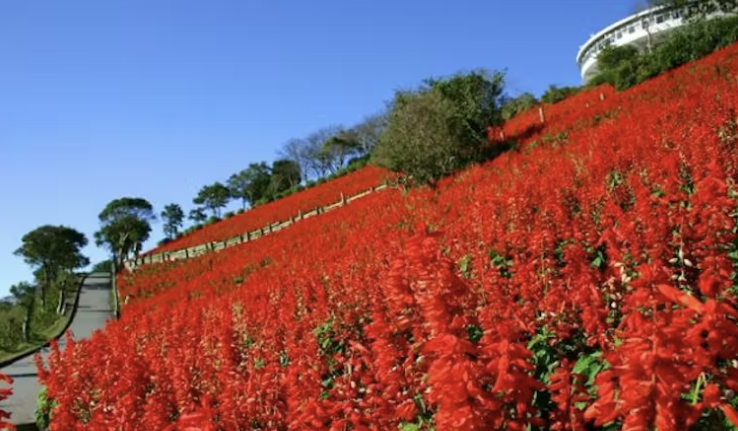
Mother Farm, located in Chiba Prefecture’s Futtsu City, offers a delightful array of seasonal blooms, including spring rape blossoms, summer petunias, hydrangeas, and autumn cosmos. Visitors can also engage in activities such as strawberry picking, blueberry picking, and sweet potato digging. Notably, the farm boasts an impressive display of salvias, with approximately 300,000 trees in full bloom from early September to mid-October.
2. Tottori Flower corridor
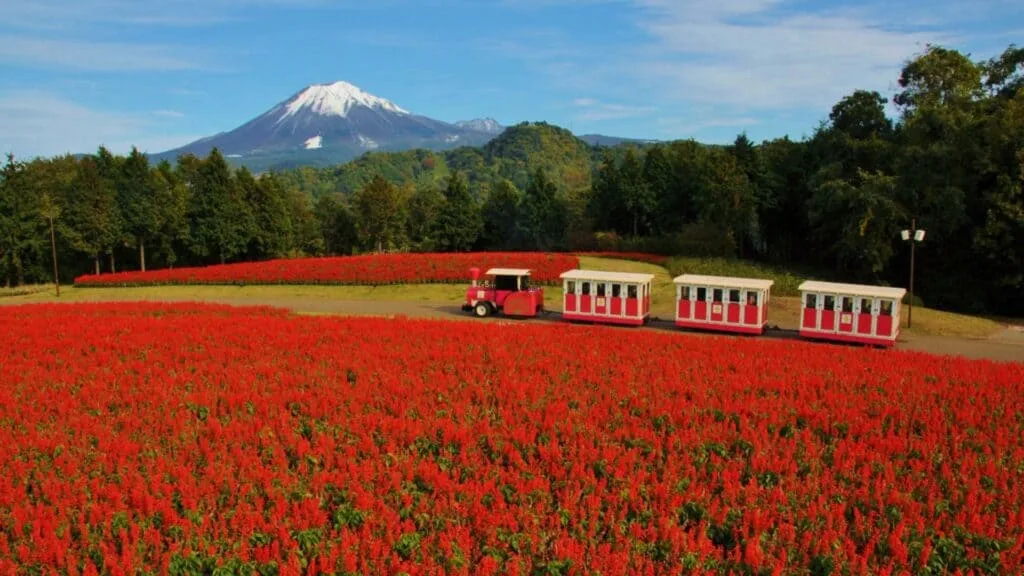
Tottori Floral Garden is a vast flower park, spanning an area equivalent to around 11 Tokyo Domes.
Among its attractions is the “Flower Hill,” a sprawling flower field that changes hues with the seasons, and “Flowers,” featuring flower beds reminiscent of the renowned Dutch park “Keukenhof Park.” The park is centred around the expansive Flower Dome, and visitors can explore various facilities within the “No Valley.” Moreover, a 1 kilometre-long covered viewing walkway ensures enjoyment of the park even on rainy days, with approximately 40 different types of salvias and 100,000 other floral specimens adorning the landscape.
3. Kuju Flower Park

Situated amidst the picturesque Kuju mountain range and Mt. Aso, Aso National Park’s Kuju Flower Park offers breathtaking views of nature. With approximately 500 types and 5 million blooms, the park dazzles visitors from April to autumn. At Aya no Oka, visitors can marvel at the Salvia in Kuju Flower Park, complemented by the striking contrast between the flower field and distant mountains.
4. Omiya Hananooka Norin Koen

In Nishi-ku, Saitama City, Saitama Prefecture, Omiya Hananooka Norin Koen boasts around 33,000 salvias, including the vibrant red flowering bonfire and dark blue salvia varieties. From July to the end of October, visitors can enjoy the fiery red hues of the salvia flowers, with the flowering season extending pleasantly into late autumn.
The diverse floral displays in Japan offer a kaleidoscope of colours, shapes, types, and sizes, ensuring visitors are treated to a visual feast regardless of the season. From the delicate cherry blossoms of spring to the vibrant hues of summer blooms and the rich tones of autumn foliage, Japan’s floral landscape is a testament to the country’s natural beauty and cultural heritage.
Whether you find yourself wandering through the vast flower parks of Tottori Floral Garden, marvelling at the panoramic views of Aso National Park’s Kuju Flower Park, or discovering the vibrant displays at Omiya Hananooka Norin Koen in Saitama City, each destination promises a unique and unforgettable experience.
With their diverse array of colours and varieties, salvias offer a captivating glimpse into Japan’s natural beauty and cultural heritage. So, why not embark on a journey to explore these exquisite blooms firsthand and immerse yourself in the splendour of Japanese flowers?
Find out all about the different flowers in Japan you can enjoy throughout the year. Click the links to check out when and where to see Cherry Blossoms, Tulips, Azaleas, Roses, Poppies, Salvia, Hydrangea, Iris, Lavender, Indian Lotus, Sunflowers, Ume, and Moss phlox.

